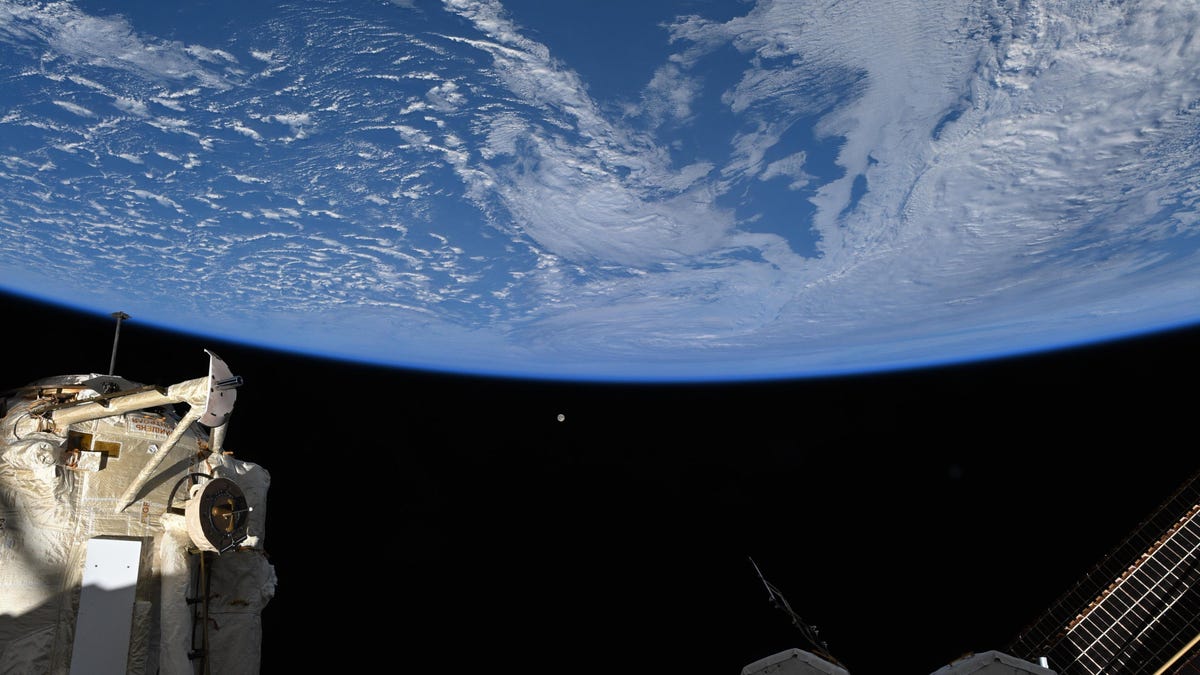Technologies
Coolest Space Photos of 2025 Will Fill You With Cosmic Wonder
From a Mars rover selfie to an astronaut’s view of the flower moon, these space images will give you a new perspective on our planet and our universe.

There’s always something happening in space, and humanity is documenting it more quickly and clearly than ever before. Orbiting telescopes, astronauts and spacecraft are sending back a stream of photos that show off the diversity and wonder of the universe. Here are some of the best space photos of the year, so far.
Los Angeles wildfires
It wasn’t just imagery of objects beyond Earth that caught our eye over the first half of the year. The European Space Agency’s Sentinel-2 Earth-observing satellite documented the devastating Palisades Fire in California in January.
The Jan. 7 view showed a large smoke plume stretching out over the Pacific Ocean. That was just the beginning of a series of wildfires that destroyed residences and buildings in Los Angeles County.
Earth from space
NASA astronaut and astrophotographer extraordinaire Don Pettit shared a knockout view of Earth from the International Space Station in late February. «Cosmic colors at sunrise; never get tired of seeing what the new day brings,» he said.
This photo has it all: our planet, swirling aurora lights and a sweeping vista of stars.
Sunrise from the moon
It’s tough to land successfully on the moon. Firefly Aerospace pulled off the feat in March with its Blue Ghost Mission 1. The Blue Ghost lander captured a historic view of a sunrise from the surface of the moon. The image shows the pockmarked lunar surface with the bright flash of the sun topping the horizon.
Many moon missions, including Intuitive Machine’s 2025 attempt, go wrong. That makes Blue Ghost’s sunrise image all the more poignant. It marks a hard-earned lunar success story.
Webb spots a ‘cosmic tornado’
The James Webb Space Telescope delivered a wild view of Herbig-Haro 49/50 in March. NASA described the space object as «a frothy-looking outflow from a nearby protostar» and a «cosmic tornado.» Look for the distant spiral galaxy in the upper left.
Hubble turns 35
The venerable Hubble Space Telescope celebrated 35 years in orbit in April. NASA and ESA partied down by releasing a series of Hubble anniversary images, including views of Mars and a barred spiral galaxy.
It’s hard to pick just one anniversary image to highlight, but the telescope’s ethereal view of the Rosette Nebula and its smoky clouds of gas and dust stands out. The nebula is a place of active star formation. Hubble’s image focuses on one small, scenic part of the Rosette.
Flower moon from orbit
NASA astronaut Nichole Ayers got some full-moon photography in during May’s «flower moon.» Ayers had a front-row seat to the glowing lunar action from her perch on the International Space Station.
Ayers shared a series of photos with Earth in the frame, emphasizing the relationship between our blue planet and our lunar neighbor.
Mars rover selfie
NASA’s Perseverance rover has been trucking around Mars since early 2021. The wheeled explorer marked its 1,500th Martian day on May 10 by taking a fresh selfie. Percy took dozens of images of itself using a camera mounted on the end of its robotic arm. NASA stitched the shots together to create the selfie.
Look deeper into the image to spot a swirling dust devil dancing in the background. «Having the dust devil in the background makes it a classic,» said Perseverance imaging scientist Megan Wu. «This is a great shot.»
The year is not even half over. There are full moons, auroras, space launches and meteor showers coming down the line. Satellites are watching over Earth. Space telescopes are staring out into the cosmos and sending back postcards from our universe.
Stay tuned for more stunning images.
Technologies
Live-Action ‘Call of Duty’ Movie Reportedly Being Co-Written by Taylor Sheridan
The Yellowstone co-creator will reportedly team up with Peter Berg on the Paramount film.

Yellowstone, Landman and, now, Call of Duty. Taylor Sheridan, co-creator of the aforementioned hit shows, will co-write Paramount and Activision’s upcoming live-action video game adaptation, according to a report from Variety on Thursday.
Peter Berg will also co-write and direct the movie, which was announced last month. Berg previously directed films including 2018’s Mile 22, 2012’s Battleship and 2013’s Lone Survivor, while Sheridan’s movie credits include 2016’s Hell or High Water and 2017’s Wind River. Berg, Sheridan and David Glasser will produce the Call of Duty film.
Don’t miss any of our unbiased tech content and lab-based reviews. Add CNET as a preferred Google source.
Call of Duty is a first-person shooter military video game series that debuted in 2003. CNET senior writer David Lumb calls it «arguably the biggest shooter franchise in gaming, with millions of players picking up every year’s new entry to the series.»
Lumb said the franchise is known for its bombastic single-player campaigns, which feature globe-spanning plots that rival those of the Mission Impossible films. «A Call of Duty movie has a lot of material to draw from,» Lumb said.
He also noted that Berg’s direction of Lone Survivor would fit the grim military heroism of Call of Duty, while Taylor Sheridan’s spate of neo-Western films and shows could lend a frontier adventurism to the film.
«Their collective works seemingly harmonize with the jingoistic pro-military tune of Activision’s shooter franchise — which is probably a good thing for Call of Duty fans,» Lumb concluded.
A release announcing Paramount and Activision’s film deal teased that it’ll be «designed to thrill its massive global fan base by delivering on the hallmarks of what fans love about the iconic series, while boldly expanding the franchise to entirely new audiences.» It didn’t include cast or plot information.
The update follows recent news that Sheridan is leaving Paramount for NBCUniversal. Paramount did not immediately respond to a request for comment.
Technologies
US Government Urges Total Ban of Our Most Popular Wi-Fi Router
Technologies
Animal Crossing Update Adds Lego Furniture, With a Switch 2 Version Arriving the Same Day
Fans of Animal Crossing will have a reason to go back to their island.

Animal Crossing fans just received a big surprise, and it’s not just a new content update. A Switch 2 version is on its way.
Animal Crossing: New Horizons will receive its first big update in three years, according to a post from Nintendo on Thursday. The update, labeled 3.0, will roll out on Jan. 15, the same day the Switch 2 version of the game will be available for purchase.
Released for the original Switch back in 2020, New Horizons was the first Animal Crossing game to come to a Nintendo console since 2008’s Animal Crossing: City Folk for the Nintendo Wii.
Nintendo regularly updated New Horizons for two years after its release, but stopped at update 2.0.6 released in November 2022. Two updates were added earlier in the year to prepare the game for playability on the Switch 2.
Animal Crossing 3.0 Update
In the 3.0 update coming on Jan. 15, a new hotel is opening. Players can help bring in guests to stay at the hotel by decorating guest rooms and dressing up mannequins to sell resort clothing.
For those who haven’t touched New Horizons in years, a Reset Service will be available. Players can have their island cleaned up, and items can be stored away or trashed for those who want a clean slate.
Players with a Nintendo Switch Online membership will have access to up to three islands, where they can explore and do as they please. These new areas are available on Slumber Island. It’s up to the player to decide how the island will look, what items or plants are on it and even which characters will be found on the island. Players can also invite friends to build it together.
New Horizons will feature special collaborations and Nintendo retro gear. Lego items will be available in the update for players to decorate their homes with or clothing to dress up their villagers with. Retro Nintendo consoles, such as the NES and Game Boy, can also be used as decorative items.
If the player has a Switch Online subscription, some classic titles such as Ice Climbers and Dr. Mario can be played via these in-game devices. There are also special items based on The Legend of Zelda and Splatoon series when players tap their amiibo from those games onto the Switch while playing.
Animal Crossing: New Horizons on Switch 2
Switch 2 owners can get in on the digital life game with Animal Crossing: New Horizons — Nintendo Switch 2 Edition. Not only will this new version come with updated graphics, including 4K resolution in TV mode, but it will also add special features that can only be done on the newest console.
One of the features is mouse controls for the Joy-Con 2. Players will be able to use the controller as a mouse to decorate indoors, create custom designs and write handwritten messages for the bulletin board.
Residents in the game can now be found by saying their name into the Switch 2’s built-in microphone while using the megaphone in the game. Multiplayer has also improved dramatically, with 12-player sessions available for those playing on the new edition, and CameraPlay is supported to allow players to see one another.
Animal Crossing: New Horizons for the Nintendo Switch 2 will be available for purchase on Jan. 15 for $65. Owners of the original Switch version of New Horizons can upgrade to the Switch 2 version for $5.
-

 Technologies3 года ago
Technologies3 года agoTech Companies Need to Be Held Accountable for Security, Experts Say
-

 Technologies3 года ago
Technologies3 года agoBest Handheld Game Console in 2023
-

 Technologies3 года ago
Technologies3 года agoTighten Up Your VR Game With the Best Head Straps for Quest 2
-

 Technologies4 года ago
Technologies4 года agoVerum, Wickr and Threema: next generation secured messengers
-

 Technologies4 года ago
Technologies4 года agoBlack Friday 2021: The best deals on TVs, headphones, kitchenware, and more
-

 Technologies4 года ago
Technologies4 года agoGoogle to require vaccinations as Silicon Valley rethinks return-to-office policies
-

 Technologies4 года ago
Technologies4 года agoOlivia Harlan Dekker for Verum Messenger
-

 Technologies4 года ago
Technologies4 года agoiPhone 13 event: How to watch Apple’s big announcement tomorrow
